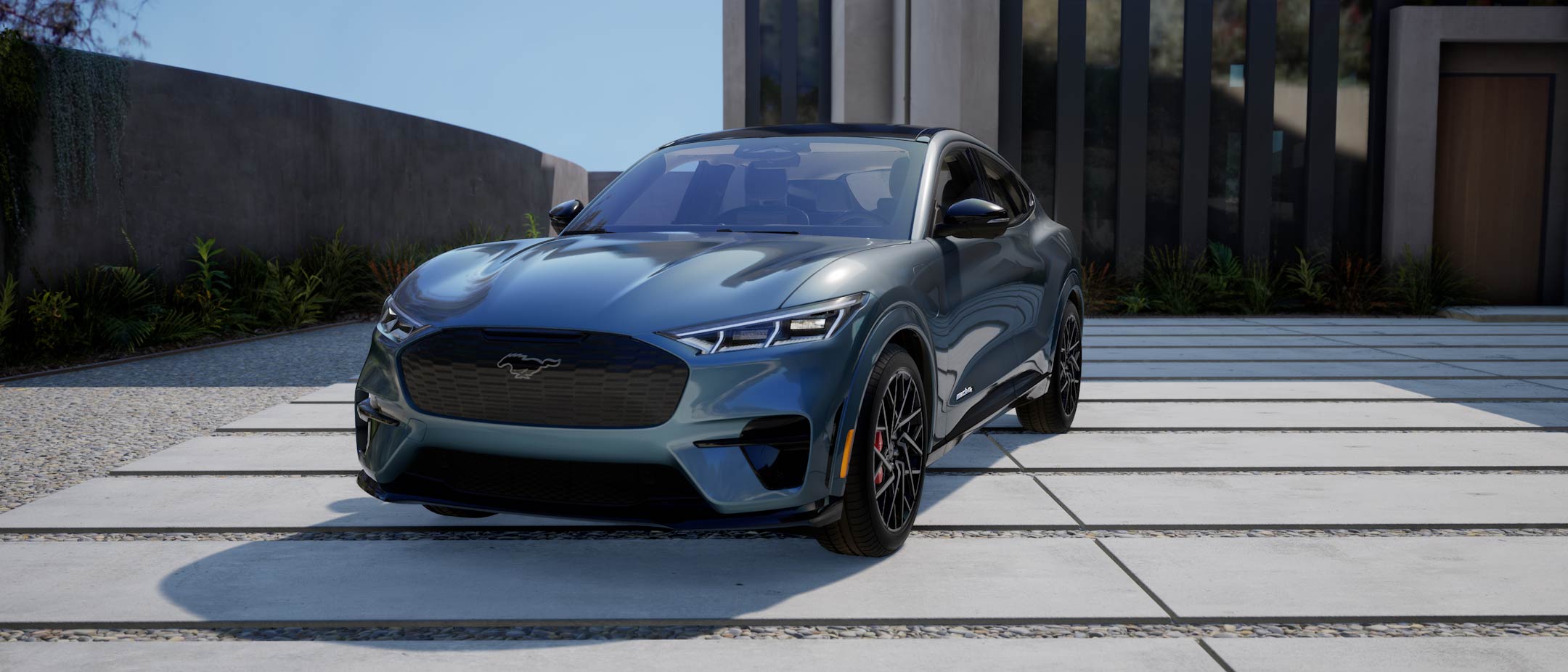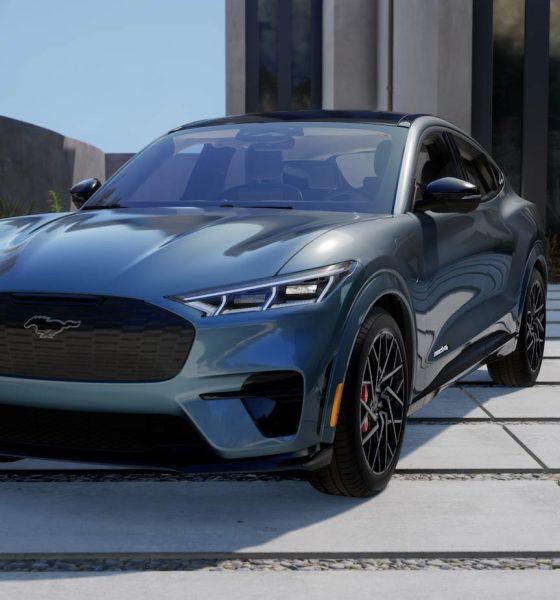

News
Ford cuts Mustang Mach-E prices, increases range as it re-opens orders
Ford has re-opened order banks on the Mustang Mach-E while simultaneously rolling back prices and increasing range.
The ability to order the Mustang Mach-E once again was opened because of plant upgrades that Ford completed, which will help ramp production volume in the second half of 2023.
Ford has boosted the range of the Standard Range battery models to a range of 250 miles for the Rear-Wheel-Drive powertrain, according to EPA estimates, while the e-All-Wheel-Drive (eAWD) will have 226 miles.
Standard Range models are now powered by lithium iron phosphate, or LFP battery cells, which allows the eAWD configuration to utilize 45 additional horsepower while adding the additional mileage to each trim level’s range.
LFP batteries are widely available and have helped automakers avoid supply chain issues and battery cell shortages, as other chemistries are not always in heavy supply. Additionally, LFP cells have the ability to operate more efficiently and like to be at a 100 percent state of charge, and can also charge faster.
Tesla used the same strategy with its Standard Range+ Model 3.
Elon Musk explains Tesla’s LFP Battery strategy for US Model 3 SR+
On top of the upgrades in terms of the range and new battery cell chemistries, Ford also rolled back the prices of Mustang Mach-E trims:
- Select RWD Standard Range – $42,995 (down $3,000)
- Select AWD Standard Range – $45,995 (down $3,000)
- California Route 1 AWD Extended Range – $56,995 (down $1,000)
- Premium RWD Standard Range – $46,995 (down $4,000)
- Premium AWD Standard Range – $49,995 (down $4,000)
- GT AWD Extended Range – $59,995 (down $4,000)
The price cuts come as EV brands continue to battle and refine costs to remain competitive. Tesla has routinely adjusted prices on its vehicles, and Ford has been one of the few to directly respond to the automaker with price cuts of its own on several occasions.
Chief Customer Officer of Ford’s EV unit, Model e, Marin Gjaja, commented on the automaker’s upgrades of the Mustang Mach-E:
“Upgraded BlueCruise rolling out for new and existing Mustang Mach-E owners, increased range, and faster DC charging times on standard range models show how we are relentlessly improving our products for our customers.”We continue to find ways to improve the value of the Mustang Mach-E.”
The Mustang Mach-E also qualifies for federal tax credits from the Inflation Reduction Act, but not the full $7,500. Instead, it qualifies for $3,750 in potential credits.
New Mustang Mach-E purchases will have 90 days of BlueCruise included, which will allow owners to experience hands-free driving on highways. The free trial is included as Ford said the new Mustang Mach-E vehicles will be fitted with all necessary hardware for the BlueCruise capabilities.
“This provides customers the opportunity to try it during the initial months of vehicle ownership and subsequently activate it through a subscription at the time of their choosing. Customers can still include a 3-year subscription as part of the vehicle purchase, if they prefer,” Ford said.
BlueCruise is equipped on 199,000 Ford and Lincoln vehicles in North America, which have accumulated over 70 million miles driven hands-free.
I’d love to hear from you! If you have any comments, concerns, or questions, please email me at joey@teslarati.com. You can also reach me on Twitter @KlenderJoey, or if you have news tips, you can email us at tips@teslarati.com.

News
Tesla starts showing how FSD will change lives in Europe
Local officials tested the system on narrow country roads and were impressed by FSD’s smooth, human-like driving, with some calling the service a game-changer for everyday life in areas that are far from urban centers.

Tesla has launched Europe’s first public shuttle service using Full Self-Driving (Supervised) in the rural Eifelkreis Bitburg-Prüm region of Germany, demonstrating how the technology can restore independence and mobility for people who struggle with limited transport options.
Local officials tested the system on narrow country roads and were impressed by FSD’s smooth, human-like driving, with some calling the service a game-changer for everyday life in areas that are far from urban centers.
Officials see real impact on rural residents
Arzfeld Mayor Johannes Kuhl and District Administrator Andreas Kruppert personally tested the Tesla shuttle service. This allowed them to see just how well FSD navigated winding lanes and rural roads confidently. Kruppert said, “Autonomous driving sounds like science fiction to many, but we simply see here that it works totally well in rural regions too.” Kuhl, for his part, also noted that FSD “feels like a very experienced driver.”
The pilot complements the area’s “Citizen Bus” program, which provides on-demand rides for elderly residents who can no longer drive themselves. Tesla Europe shared a video of a demonstration of the service, highlighting how FSD gives people their freedom back, even in places where public transport is not as prevalent.
What the Ministry for Economic Affairs and Transport says
Rhineland-Palatinate’s Minister Daniela Schmitt supported the project, praising the collaboration that made this “first of its kind in Europe” possible. As per the ministry, the rural rollout for the service shows FSD’s potential beyond major cities, and it delivers tangible benefits like grocery runs, doctor visits, and social connections for isolated residents.
“Reliable and flexible mobility is especially vital in rural areas. With the launch of a shuttle service using self-driving vehicles (FSD supervised) by Tesla in the Eifelkreis Bitburg-Prüm, an innovative pilot project is now getting underway that complements local community bus services. It is the first project of its kind in Europe.
“The result is a real gain for rural mobility: greater accessibility, more flexibility and tangible benefits for everyday life. A strong signal for innovation, cooperation and future-oriented mobility beyond urban centers,” the ministry wrote in a LinkedIn post.
News
Tesla China quietly posts Robotaxi-related job listing
Tesla China is currently seeking a Low Voltage Electrical Engineer to work on circuit board design for the company’s autonomous vehicles.

Tesla has posted a new job listing in Shanghai explicitly tied to its Robotaxi program, fueling speculation that the company is preparing to launch its dedicated autonomous ride-hailing service in China.
As noted in the listing, Tesla China is currently seeking a Low Voltage Electrical Engineer to work on circuit board design for the company’s autonomous vehicles.
Robotaxi-specific role
The listing, which was shared on social media platform X by industry watcher @tslaming, suggested that Tesla China is looking to fill the role urgently. The job listing itself specifically mentions that the person hired for the role will be working on the Low Voltage Hardware team, which would design the circuit boards that would serve as the nervous system of the Robotaxi.
Key tasks for the role, as indicated in the job listing, include collaboration with PCB layout, firmware, mechanical, program management, and validation teams, among other responsibilities. The role is based in Shanghai.
China Robotaxi launch
China represents a massive potential market for robotaxis, with its dense urban centers and supportive policies in select cities. Tesla has limited permission to roll out FSD in the country, though despite this, its vehicles have been hailed as among the best in the market when it comes to autonomous features. So far, at least, it appears that China supports Tesla’s FSD and Robotaxi rollout.
This was hinted at in November, when Tesla brought the Cybercab to the 8th China International Import Expo (CIIE) in Shanghai, marking the first time that the autonomous two-seater was brought to the Asia-Pacific region. The vehicle, despite not having a release date in China, received a significant amount of interest among the event’s attendees.
Elon Musk
Elon Musk and Tesla AI Director share insights after empty driver seat Robotaxi rides
The executives’ unoccupied tests hint at the rapid progress of Tesla’s unsupervised Robotaxi efforts.

Tesla CEO Elon Musk and AI Director Ashok Elluswamy celebrated Christmas Eve by sharing personal experiences with Robotaxi vehicles that had no safety monitor or occupant in the driver’s seat. Musk described the system’s “perfect driving” around Austin, while Elluswamy posted video from the back seat, calling it “an amazing experience.”
The executives’ unoccupied tests hint at the rapid progress of Tesla’s unsupervised Robotaxi efforts.
Elon and Ashok’s firsthand Robotaxi insights
Prior to Musk and the Tesla AI Director’s posts, sightings of unmanned Teslas navigating public roads were widely shared on social media. One such vehicle was spotted in Austin, Texas, which Elon Musk acknowleged by stating that “Testing is underway with no occupants in the car.”
Based on his Christmas Eve post, Musk seemed to have tested an unmanned Tesla himself. “A Tesla with no safety monitor in the car and me sitting in the passenger seat took me all around Austin on Sunday with perfect driving,” Musk wrote in his post.
Elluswamy responded with a 2-minute video showing himself in the rear of an unmanned Tesla. The video featured the vehicle’s empty front seats, as well as its smooth handling through real-world traffic. He captioned his video with the words, “It’s an amazing experience!”
Towards Unsupervised operations
During an xAI Hackathon earlier this month, Elon Musk mentioned that Tesla owed be removing Safety Monitors from its Robotaxis in Austin in just three weeks. “Unsupervised is pretty much solved at this point. So there will be Tesla Robotaxis operating in Austin with no one in them. Not even anyone in the passenger seat in about three weeks,” he said. Musk echoed similar estimates at the 2025 Annual Shareholder Meeting and the Q3 2025 earnings call.
Considering the insights that were posted Musk and Elluswamy, it does appear that Tesla is working hard towards operating its Robotaxis with no safety monitors. This is quite impressive considering that the service was launched just earlier this year.








